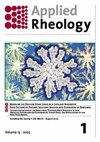瞬态粒子追踪血浆内在途径的微流变学
IF 5.8
4区 工程技术
Q1 MECHANICS
引用次数: 0
摘要
摘要维持止血以确保血管完整性取决于凝血级联的酶原物质快速转化为其酶活性形式。这一过程最终产生丝氨酸蛋白酶凝血酶和纤维蛋白聚合,以防止内皮细胞损伤或细胞连接缺失部位的血管渗漏。凝血酶的产生可以通过将血液暴露于血管损伤部位的组织因子而由外源性凝血途径启动,或者通过接触激活途径由具有负电荷的外来表面(如玻璃)激活的凝血因子(F)XII启动。在这里,我们使用瞬态粒子跟踪微流变学来研究纤维蛋白对两种凝血途径下游凝血酶产生的反应的力学性质。我们发现纤维蛋白形成的结构异质性取决于凝血酶生成的反应动力学。FXII活性的药理学抑制延长了纤维蛋白形成的时间,并增加了纤维蛋白的异质性程度,导致纤维蛋白凝块的机械性能降低。总之,这项研究证明了纤维蛋白形成的物理生物学依赖于凝血接触途径的激活。本文章由计算机程序翻译,如有差异,请以英文原文为准。
Transient particle tracking microrheology of plasma coagulation via the intrinsic pathway
Abstract The maintenance of hemostasis to ensure vascular integrity is dependent upon the rapid conversion of zymogen species of the coagulation cascade to their enzymatically active forms. This process culminates in the generation of the serine protease thrombin and polymerization of fibrin to prevent vascular leak at sites of endothelial cell injury or loss of cellular junctions. Thrombin generation can be initiated by the extrinsic pathway of coagulation through exposure of blood to tissue factor at sites of vascular damage, or alternatively by the coagulation factor (F) XII activated by foreign surfaces with negative charges, such as glass, through the contact activation pathway. Here, we used transient particle tracking microrheology to investigate the mechanical properties of fibrin in response to thrombin generation downstream of both coagulation pathways. We found that the structural heterogeneity of fibrin formation was dependent on the reaction kinetics of thrombin generation. Pharmacological inhibition of FXII activity prolonged the time to form fibrin and increased the degree of heterogeneity of fibrin, resulting in fibrin clots with reduced mechanical properties. Taken together, this study demonstrates a dependency of the physical biology of fibrin formation on activation of the contact pathway of coagulation.
求助全文
通过发布文献求助,成功后即可免费获取论文全文。
去求助
来源期刊

Applied Rheology
物理-力学
CiteScore
3.00
自引率
5.60%
发文量
7
审稿时长
>12 weeks
期刊介绍:
Applied Rheology is a peer-reviewed, open access, electronic journal devoted to the publication in the field of applied rheology. The journal provides the readers with free, instant, and permanent access to all content worldwide; and the authors with extensive promotion of published articles, long-time preservation, language-correction services, no space constraints and immediate publication.
 求助内容:
求助内容: 应助结果提醒方式:
应助结果提醒方式:


